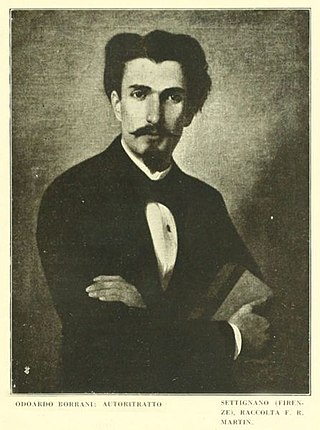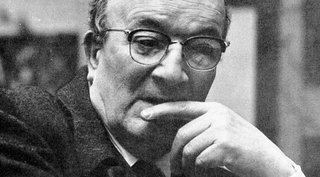Related Research Articles

Giuseppe Ferrari was an Italian philosopher, historian and politician.

The Patriarchate of Venice, also sometimes called the Archdiocese of Venice, is a Latin Church ecclesiastical territory or patriarchal archdiocese of the Catholic Church in Venice, Italy. In 1451 the Patriarchate of Grado was merged with the Bishopric of Castello and Venice to form the Archdiocese of Venice.

Roberto Carnevale is an Italian composer, pianist, conductor and academic teacher.

Alvaro Vitali is an Italian actor.

Giuseppe Pontiggia was an Italian writer and literary critic.
Lorenzo Villoresi is a perfumer in Florence, Italy. His study and travel in the Middle East has greatly influenced his work and some of his most important fragrances are Orientals, exotic perfumes of spices, amber, incense, resins, vanilla, sandalwoods and other aromatics. He continues in the long tradition of perfumery in Florence, arguably where modern perfume making began. The LV house opened in 1990 in the 15th-century family palace, overlooking the Arno.

Ansaldo Poggi was born in Villafontana di Medicina (Bologna), 9 June 1893 and died in Bologna, 4 September 1984. He demonstrated his talent for the making of stringed instruments at a young age. His father, also an artisan, musician and amateur violinmaker, encouraged his son, steering him toward the arts. After the end of World War I he dedicated himself to the profession, taking up the craft again alongside his father while at the same time graduating from the Philharmonic Academy of Bologna. In 1921 he met up with the famous luthier Giuseppe Fiorini, of whom he was an adored disciple. In 1923 he won his first silver medal with a viola at the National Competition in Rome.

Giardino delle rose is a garden park in the Oltrarno district of Florence, in Tuscany, Italy. It is located below the Piazzale Michelangelo and offers a commanding view of the city.
Stefano Valdegamberi is a Venetist politician from Veneto, Italy.
The Acqui Award of History is an Italian prize. The prize was founded in 1968 for remembering the victims of the Acqui Military Division who died in Cefalonia fighting against the Nazis. The jury is composed of seven members: six full professors of history and a group of sixty (60) ordinary readers who have just one representative in the jury. The Acqui Award Prize is divided into three sections: history, popular history, and historical novels. A special prize entitled “Witness to the Times,” given to individual personalities known for their cultural contributions and who have distinguished themselves in describing historical events and contemporary society, may also be conferred. Beginning in 2003 special recognition for work in multimedia and iconography--”History through Images”—was instituted.

The Navigium Isidis or Isidis Navigium was an annual ancient Roman religious festival in honor of the goddess Isis, held on March 5. The festival outlived Christian persecution by Theodosius (391) and Arcadius' persecution against the Roman religion (395).

Odoardo Borrani was an Italian painter associated with the Macchiaioli group.

Augusto Ponzio is an Italian semiologist and philosopher.

Ovidio Guaita is journalist, photographer and traveller. He has published over 30 books, in New York City, Rome, Paris. He works with the Faculty of Architecture of the University of Florence on research on the history of art and architecture. Since 2005 he is the Editor in Chief of Resorts Magazine, published in London by Palidano Press.

Giovanni Antonio Lecchi or Giannantonio Lecchi was an Italian Jesuit, mathematician, engineer and physicist. He lived and worked with success in Milan rising to a notable level of prominence.
Nicoletta Maraschio is an academic teacher of "History of Italian Language" at University of Florence. She was the first woman in charge of Accademia della Crusca, from 2008 to 2014, succeeding Francesco Sabatini.
Luciano Bellosi was an Italian art historian.

Emilio Cecchi was an Italian literary critic, art critic and screenwriter. One English language source describes him as "an 'official' - although radically anti-academic - intellectual".
Alfredo Lucio Esposito, also known under the pseudonym of Alfredo Fiorani, was an Italian poet, writer, essayist and man of letters.

Giampaolo Pansa was an Italian journalist-commentator and novelist, especially during his late years. Most of his writings were rooted in recent or contemporary history, notably with regard to the antifascist resistance of the Mussolini years.
References
- 1 2 Giampaolo di Cocco timet.collaboration
- ↑ il colore dell'architettura - note biografiche [ permanent dead link ]
- 1 2 Gillo Dorfles (2001) Artisti esordienti: istruzioni per il successo , Corriere della Sera, 16-9-2001, p.35
- ↑ Alle origini del Carnevale, book presentation Archived 2009-03-21 at the Wayback Machine at Angelo Pontecorboli Editore
- ↑ Daniele Luttazzi (2009) La guerra civile fredda, pp.86-96